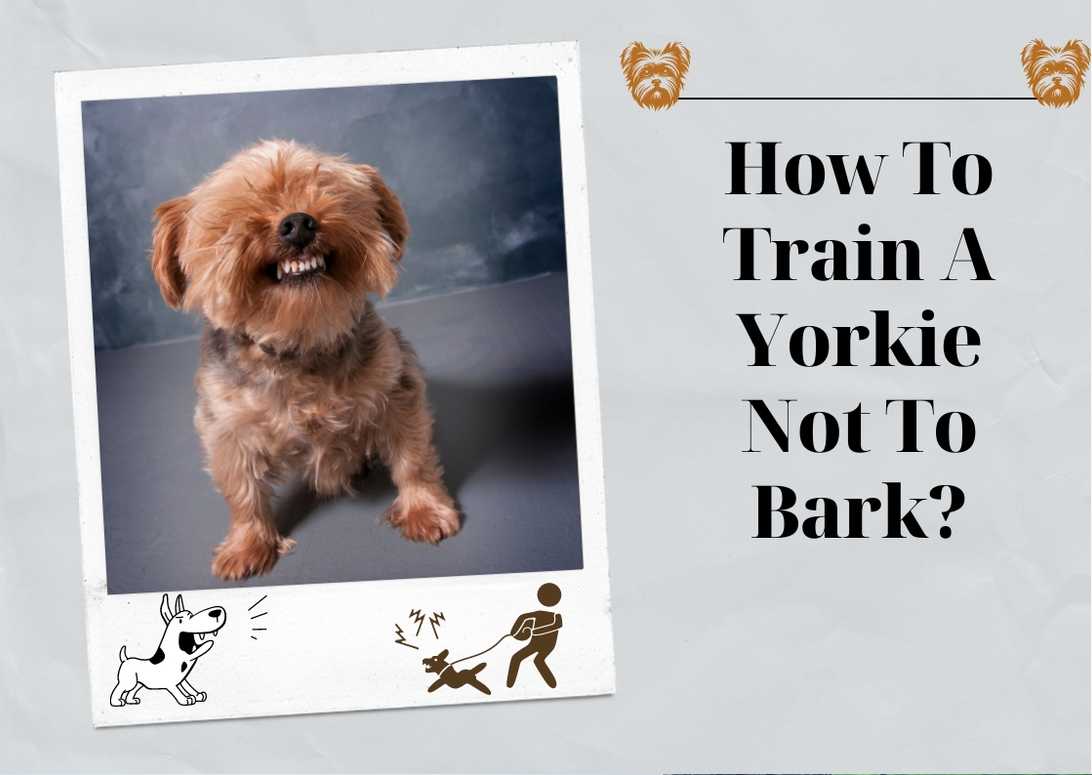How To Train A Yorkie Not To Bark?
Hey there! Are you struggling with your Yorkie’s excessive barking? Well, don’t worry because I’ve got some practical tips that can help you train your furry friend to be quiet when necessary.
In this article, I’ll share effective techniques on how to establish clear boundaries and communicate effectively with your Yorkie, so they bark only when it’s important.
Firstly, it’s important to set boundaries for your Yorkie. This means teaching them what is acceptable barking and what is not. By creating a trigger, such as a specific command or gesture, you can let your dog know when it’s appropriate to bark and when it’s time to be quiet.
Additionally, establishing a routine will help reinforce these boundaries and make the training process more effective. With consistent practice and positive reinforcement, you’ll be able to teach your Yorkie how to control their barking behavior in no time.
So let’s get started!
Important Points
- Establish clear boundaries and consistent communication with your Yorkie to help train them not to bark excessively.
- Identify triggers for excessive barking and use calming techniques to address them.
- Utilize distraction techniques and redirect your Yorkie’s attention away from barking triggers.
- Consider seeking professional help from a dog trainer if needed.
How to Stop Barking
To stop your Yorkie from barking, shake the can and say ‘Quiet’ firmly whenever it barks, then offer a treat and praise when it becomes quiet. It’s important to identify the triggers that cause excessive barking in your Yorkie. This could be someone ringing the doorbell, hearing certain noises, or even seeing other dogs outside.
Once you know what sets off your Yorkie’s barking, you can work on implementing calming techniques to help them relax and remain quiet in those situations. One effective method is to use distraction techniques to redirect your Yorkie’s attention away from whatever is causing them to bark. You can engage them in play or give them a toy or puzzle to keep their mind occupied.
Additionally, exploring different variations of the ‘quiet’ command can be helpful. Some dogs respond better to different words or gestures, so try experimenting with different cues until you find one that works best for your Yorkie.
If you’re struggling to address excessive barking on your own, don’t hesitate to seek assistance from a professional dog trainer who specializes in behavior training. They can provide guidance and support tailored specifically for your Yorkie’s needs. By using these techniques and seeking professional help if needed, you can effectively train your Yorkie not to bark excessively.
Now let’s move on to setting boundaries with your Yorkshire Terrier without writing another step.
Setting Boundaries
Setting boundaries
Establish clear boundaries with your Yorkshire Terrier by determining when and for how long it’s acceptable for them to express themselves vocally, so you can effectively communicate your expectations without resorting to constant barking. Consistency is key in setting these boundaries, as Yorkies are very good at understanding time and routine.
By consistently reinforcing the rules you’ve established, your Yorkie will learn what is expected of them and when it’s appropriate to bark. Understanding the triggers for your Yorkie’s barking is also important in order to address the behavior effectively. Is it a specific noise or doorbell ringing that sets them off? Once you identify the triggers, you can work on desensitizing them to these stimuli.
Differentiating between necessary and excessive barking is crucial in training your Yorkie not to bark excessively. While it may be desirable for them to bark when someone is at the door or there’s an intruder, continuous barking can become problematic. Set a limit on the number of barks or duration of barking that you find acceptable before using the command to quiet them down.
Positive reinforcement techniques such as offering tasty treats and praise when they remain quiet can help reinforce desired behavior. Lastly, exploring alternative methods to discourage barking without relying solely on eye contact can be beneficial. This could include using a shake can or other noise-making device every time they bark while saying “Quiet,”in a firm but forceful voice.
By following these guidelines, you’ll establish clear boundaries with your Yorkie and create a trigger-free environment where excessive barking is discouraged.
Now let’s move on to creating a trigger-free environment for effective training methods without relying solely on eye contact.
Create a Trigger
Create a stimulating environment that encourages your Yorkshire Terrier to express themselves and respond to various triggers. Using toys is a great way to engage your Yorkie and get them excited. Provide them with interactive toys that challenge their minds and keep them occupied. This not only helps prevent boredom, but it also redirects their attention away from barking unnecessarily.
Additionally, reward-based training can be highly effective in teaching your Yorkie not to bark excessively. Whenever they remain quiet in response to a trigger or command, offer them treats and praise as positive reinforcement. This will reinforce the desired behavior of staying calm and quiet.
Environmental enrichment is another important aspect of reducing excessive barking in Yorkies. Make sure your Yorkie has plenty of physical exercise and mental stimulation throughout the day. Take them for regular walks, play games with them, and provide puzzle toys or treat-dispensing toys that require problem-solving skills. A tired dog is less likely to bark incessantly out of boredom or frustration.
In addition, desensitization techniques can help your Yorkie become less reactive to certain triggers. Gradually expose them to the sounds or situations that usually cause barking, starting at a low intensity and gradually increasing over time. Pair these triggers with positive experiences such as treats or playtime so that they begin associating those stimuli with something pleasant rather than feeling anxious or threatened.
By creating an engaging environment using toys, implementing reward-based training, providing environmental enrichment, practicing desensitization techniques, and redirecting attention when necessary, you can effectively train your Yorkshire Terrier not to bark excessively. Establishing routine…
Establish Routine
Start by setting up a consistent daily schedule for your furry companion, ensuring regular feeding times, exercise sessions, and playtime to establish a sense of routine. Having a routine provides numerous benefits for your Yorkie. It helps them feel secure and reduces anxiety, which can contribute to excessive barking. By knowing what to expect each day, your Yorkie will have less reason to bark out of boredom or frustration.
Additionally, having a structured schedule makes it easier for you to incorporate training sessions into their daily routine. This allows you to dedicate specific times for teaching your Yorkie commands and reinforcing good behavior.
In addition to physical exercise and training, mental stimulation is crucial in preventing excessive barking. Incorporate activities that challenge your Yorkie’s mind, such as puzzle toys or interactive games. This not only keeps them entertained but also tires them out mentally, reducing the likelihood of incessant barking due to pent-up energy or boredom.
When introducing new triggers or stimuli that may provoke barking, do so gradually and in controlled environments. For example, if you want your Yorkie to get used to the sound of doorbells without going into a barking frenzy each time someone rings it, start by playing recorded doorbell sounds at low volume while rewarding calm behavior with treats and praise. Gradually increase the volume over time until your Yorkie becomes desensitized and learns not to react excessively.
By establishing a consistent routine for your Yorkie and providing ample mental stimulation throughout the day, you can greatly reduce their inclination to bark unnecessarily.
Now let’s move on to the next section about positive reinforcement techniques for effective training without using contractions.
Positive Reinforcement
Enhance your Yorkie’s training experience by utilizing positive reinforcement techniques that’ll keep them engaged and eager to learn. Reward-based training methods are highly effective in teaching a Yorkie not to bark excessively. Whenever your Yorkie remains quiet when prompted, reward them with a tasty treat and praise. This positive association will reinforce their understanding that being quiet leads to good things.
Using treats for positive reinforcement can be a powerful tool in shaping desired behavior. When your Yorkie barks, redirect their attention to a toy or an activity they enjoy and reward them for engaging in that instead of barking. This teaches them that there are alternative behaviors that can be more rewarding than excessive barking.
Clicker training can also be helpful in controlling your Yorkie’s barking. By associating the sound of the clicker with rewards, you can effectively communicate when they’ve done something desired, such as staying quiet on command. Clicking and treating every time they respond appropriately helps establish the connection between the clicker sound and the desired behavior.
Consistency is key when training any dog breed, including Yorkshire Terriers. Be consistent in implementing these positive reinforcement techniques and always reward your Yorkie for remaining calm and not barking unnecessarily. With time and patience, they’ll understand what’s expected from them.
Transitioning into the subsequent section about avoiding eye contact: Now that we’ve covered some effective ways to train your Yorkie not to bark through positive reinforcement techniques, let’s explore another aspect of this training process – avoiding eye contact as a method for establishing pack leadership.
Avoid Eye Contact
Establishing your leadership role with your Yorkshire Terrier can be as simple as avoiding direct eye contact. Dogs perceive eye contact as a sign of dominance, so by not engaging in prolonged eye contact with your Yorkie, you’re showing that you’re not trying to assert dominance over them.
Instead, focus on using body language and positive reinforcement techniques to communicate with your furry companion.
When training your Yorkie not to bark excessively, it’s crucial to redirect their behavior in a positive way. If they start barking unnecessarily, try using distractions such as toys or treats to divert their attention elsewhere. By providing them with an alternative focus and rewarding them for being quiet, you’re teaching them that there are better ways to communicate and seek attention.
Understanding the reasons behind excessive barking can also help address the issue more effectively. Is your Yorkie barking out of fear, anxiety, or boredom? Identifying the underlying cause will enable you to tackle it at its root.
Consistency is key when training any dog breed, including Yorkies.
Consistency
To effectively address excessive barking in your Yorkshire Terrier, it’s crucial to maintain consistency in your approach. Consistency means implementing the same training techniques and rules every time your Yorkie barks excessively. This helps them understand what’s expected of them and reinforces the desired behavior.
Here are some tips for consistent training:
Understanding the reasons behind excessive barking: It’s important to identify why your Yorkie is barking excessively. Is it out of fear, boredom, or attention-seeking? Once you understand the underlying cause, you can tailor your training approach accordingly.
Using positive reinforcement techniques effectively: Rewarding your Yorkie with treats, praise, or playtime when they’re quiet can help reinforce good behavior. Make sure to offer these rewards immediately after they stop barking so they associate being quiet with positive outcomes.
Incorporating obedience training into your routine: Obedience training provides structure and teaches your Yorkie basic commands such as ‘sit,’ ‘stay,’ and ‘quiet.’ Practice these commands consistently throughout the day to establish a clear communication channel between you and your dog.
Managing barking behavior in different environments: Your Yorkie may bark more in certain environments, such as when visitors come over or during walks. Gradually expose them to these situations while using consistent training methods to teach them appropriate behavior.
By maintaining consistency in your approach and following these tips, you can effectively train your Yorkshire Terrier not to bark excessively. Remember, patience and persistence are key when it comes to modifying their behavior.
Frequently Asked Questions
Can I use any type of treat for positive reinforcement when training my Yorkie not to bark?
Yes, you can use different treat options for positive reinforcement when training your Yorkie not to bark. It’s important to properly use positive reinforcement by rewarding them with treats and praise when they’re quiet. If persistent barking continues, consider using alternative methods and addressing the specific challenges of training Yorkies.
Is it necessary to shake a can every time my Yorkie barks, or are there other methods that can be effective?
There are alternative methods to using a can shake for training a Yorkie not to bark. Clicker training can be effective in reducing barking behavior, and desensitization and counterconditioning techniques can also address excessive barking. Verbal cues can be used instead of physical deterrents, but consistency and patience are key.
What should I do if my Yorkie continues to bark even after using the command to quiet him?
If my Yorkie continues to bark even after using the command to quiet him, I would consider alternative methods for behavior modification such as teaching him a “quiet”cue or addressing any underlying reasons for excessive barking. Consistency and patience are key, and finding the right balance between positive reinforcement and correction is important. If needed, I would also seek professional help from a dog trainer.
Are there any specific training techniques that work best for Yorkshire Terriers compared to other breeds?
Breed specific training techniques for Yorkies include consistent Yorkie obedience training, using effective strategies to reduce barking, and employing behavior modification techniques. Training tips for Yorkie owners involve firm but gentle commands, positive reinforcement, and clear communication.
How long does it typically take to see results when training a Yorkie not to bark?
Training a Yorkie not to bark can take time, like waiting for a flower to bloom. Understanding their behavior is key, and progress varies. Common challenges include consistency and patience. Effective strategies involve positive reinforcement, shake cans, treats, and firm commands.
Conclusion
In conclusion, training a Yorkie not to bark excessively requires patience, consistency, and effective communication. By following the tips outlined in this article, you can establish clear boundaries and create a harmonious environment for both you and your furry friend.
One anecdote that illustrates the importance of consistency in training is the story of Lucy, a Yorkie who used to bark constantly at every little sound or movement. Her owner, Sarah, decided to implement consistent techniques by using positive reinforcement whenever Lucy remained quiet during potentially triggering situations. Over time, Lucy learned that she would receive treats and praise when she refrained from barking unnecessarily.
This story serves as a metaphor for life’s challenges. Just as Lucy had to learn self-control and recognize when it was appropriate to remain silent, we too must navigate various situations with composure and choose our responses wisely. By establishing clear boundaries and consistently reinforcing positive behavior, we can find harmony amidst chaos and effectively communicate our needs without unnecessary noise.
Remember, training a Yorkie not to bark excessively is a process that takes time. With patience and dedication, you can establish a peaceful environment for both you and your beloved pet. So start today by implementing these tips and watch as your Yorkie learns to control their barking behavior while still alerting you to potential dangers or disturbances when necessary.








